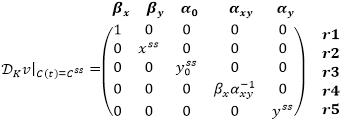Metabolic control analysis example
The method description could be found in the section Metabolic Control Analysis. Here we give an example of the method application and using in BioUML.
The theory of metabolic control determines sensitivity of steady metabolic fluxes (reaction rates) vss and steady state Css of an ODE model under perturbation of its parameters K [1]. Unlike the Sensitivity Analysis, this method does not require the computation of values Css(p + Δp), p ∈ K, that can accelerate the model research. Instead, to analyze matrixes ƊKCss and ƊKvss of partial derivatives of Css and vss with respect to parameters K, the method considers a matrix ƊKv|C(t) = Css of partial derivatives of a vector v(t) with respect to K in a steady state of the model, and searches for control matrices Γ and Λ, such that
In accordance with [1], these matrices can be calculated by formulas
where NR is a matrix consisting of linearly independent rows of the model stoichiometric matrix N of n by m, L is a transition matrix such that: N = L · NR, and ƊCssv is a matrix of elasticity coefficients
Consider the model of p53 and Mdm2 proteins regulation described in the example for Sensitivity Analysis. For this model, we get:
Next, we find the matrixes N and ƊCssv:
Since NR = N and L is the identity matrix of 3 by 3, we can calculate the matrix product N · ƊCssv:
Applying the cofactor method to the resulting matrix, we deduce:
Thus, we have:
Take into account the formulas for calculation of the model steady state derived in the Sensitivity Analysis example:
Using these formulas, we can convert matrix Γ to the form:
Multiplication of the calculated matrices Γ and ƊKv|C(t) = Css gives the same matrix ƊKCss, as in the example for Sensitivity Analysis:
References
- Reder C. Metabolic control theory: a structural approach. Journal of Theoretical Biology. 1988. V. 135. № 2. p. 175-201.







